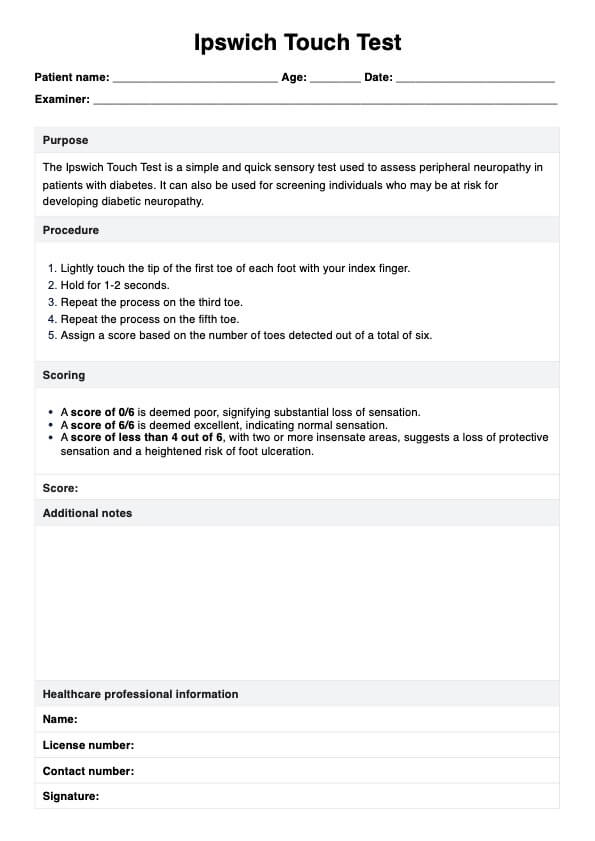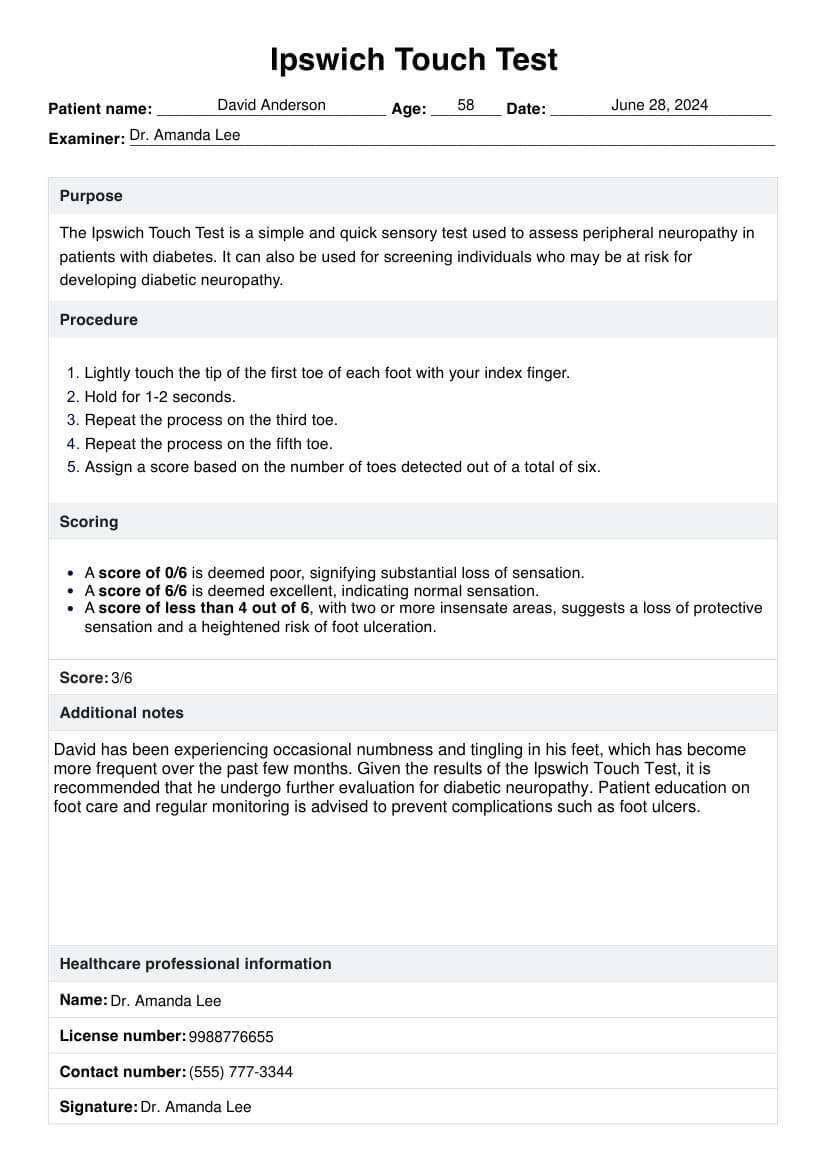Ipswich Touch Test
Learn about the Ipswich Touch Test, a simple and effective way to assess the risk of diabetic foot ulcers. Download a free PDF template here.


What are foot ulcers?
Foot ulcers are open sores or wounds commonly occurring on the bottom of the feet. They are a significant complication of diabetes mellitus, affecting approximately 15% of diabetic patients during their lifetime. Foot ulcers are particularly concerning because they can lead to severe infections and, in some cases, amputation if not properly managed.
Foot ulcers can manifest as redness, swelling, and sometimes drainage on the affected area. If the ulcer becomes infected, you may notice a distinct odor. Pain isn't always a primary symptom, especially for those with diabetic neuropathy, a condition that damages nerves and reduces sensation in the feet.
Individuals with diabetes, particularly those with poor blood sugar control, are at a higher risk of developing foot ulcers. Other risk factors include peripheral neuropathy, poor circulation, foot deformities, and a history of foot ulcers or amputations. Regular and previous foot ulcer screening is crucial for these at-risk populations to prevent severe complications.
Ipswich Touch Test Template
Ipswich Touch Test Example
What is the Ipswich Touch Test (IPTT)?
The Ipswich Touch Test (IPTT) is a simple, quick, and effective method for assessing the risk of foot ulcers in people with diabetes. This test involves lightly touching specific points on the patient's foot to check for sensitivity and detect diabetic peripheral sensory neuropathy, a major risk factor for diabetic neuropathic foot ulceration.
By identifying peripheral neuropathy, the IPTT helps evaluate foot ulcer risk and diabetic foot disease. The IPTT can be easily conducted in a primary health care setting, making it an excellent tool for promoting foot screening methods and early detection of at-risk feet. By incorporating this test into regular check-ups, healthcare providers can better manage diabetic foot ulceration and improve overall foot health in diabetic patients.
How to conduct the Ipswich Touch Test
To conduct this test here are some steps you can take as a healthcare professional:
- Ensure the patient's feet are clean and dry. Have them remove their shoes and socks and sit comfortably.
- Gently touch the tip of the first toe on each foot with your index finger.
- Hold your touch for 1-2 seconds.
- Repeat this process on the third toe.
- Perform the same procedure on the fifth toe.
- Assign a score based on the number of toes detected, with a maximum of six.
Scoring and interpretation
The IPTT requires healthcare professionals to assign a score based on the patient's response to touch. The scoring system is as follows:
- A score of 0/6 is considered poor, indicating significant loss of sensation.
- A score of 6/6 is considered excellent, reflecting normal sensation.
- A score of less than 4/6, with two or more areas lacking sensation, indicates a loss of protective sensation and an increased risk of foot ulceration.
Note that a score of 5/6 may also require further assessment and monitoring. Make sure to document the score and any other relevant findings in the patient's medical record.
How does our Ipswich Touch Test template work?
Our Ipswich Touch Test template is designed to streamline the process of conducting and recording the test. The template provides clear instructions and a straightforward layout for marking responses. Here's how it works:
- Download and print: Access the template from our website and print a copy for patient assessments.
- Conduct the test: Follow the step-by-step instructions provided on the template to conduct the Ipswich Touch Test.
- Record responses: Use the designated spaces to note the patient's responses and your findings.
- Interpret results: The template includes a scoring guide to help you interpret the results and determine the patient's risk level for foot ulcers.
Using our template, you can ensure consistency and accuracy in your assessments, making it easier to monitor and manage your patients' foot health.
Benefits of using our template
Using our Ipswich Touch Test template offers several advantages:
- Ease of use: The template simplifies the process, making it easy to conduct the test and record results accurately.
- Consistency: Ensures uniformity in testing, which is crucial for reliable assessments and comparisons over time.
- Documentation: Provides a clear and concise record of each test, which is useful for patient history and further evaluations.
- Patient education: Helps educate patients about their foot health status and the importance of regular screenings.
- Professional tool: Enhances the credibility and professionalism of your practice by using a standardized assessment tool.
By incorporating our template into your practice, you can improve patient outcomes through early detection and proactive management of foot health.
Management and treatment of foot ulcers
Managing and treating foot ulcers requires a comprehensive approach:
- Debridement: Removing dead or infected tissue to promote foot screening and healing.
- Infection control: Administering antibiotics if there’s an infection.
- Wound care: Regular cleaning and dressing of the ulcer to protect it and aid healing.
- Offloading: Using special footwear or devices to reduce pressure on the ulcer.
- Blood sugar management: Controls blood sugar levels to enhance healing and prevent complications.
- Monitoring: Regular follow-ups to assess healing progress and adjust treatment as necessary.
Education on proper foot care, regular screenings, and managing diabetes effectively are key to preventing the occurrence and recurrence of foot ulcers.
Commonly asked questions
The test can be performed by healthcare providers in primary care settings. It’s especially useful for those managing patients with diabetes.
For individuals with diabetes, the test should be conducted at least annually, or more frequently if they have a history of foot ulcers or other risk factors.
Results help identify the risk level for foot ulcers, guiding the need for preventive measures or further medical intervention.

.jpg)





































































































